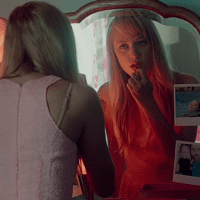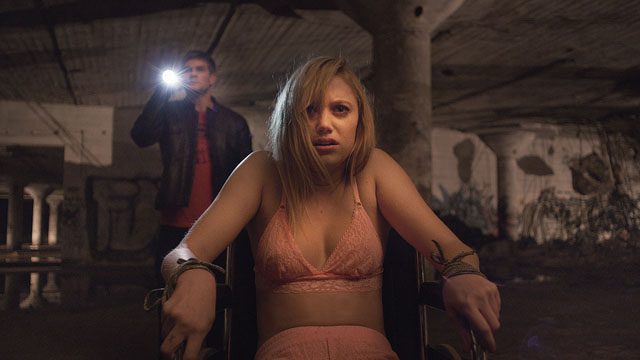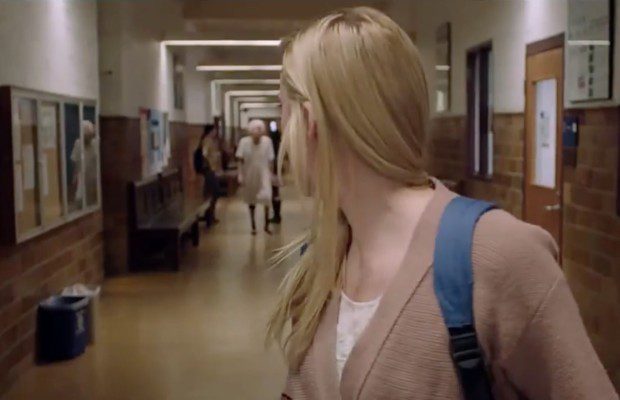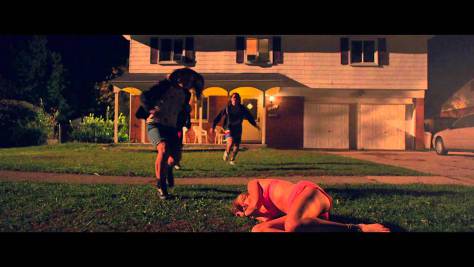In the recent horror film sensation It Follows, a young woman, Jay (Maika Monroe), watchers herself in the mirror. She’s preparing to go out with a man she only recently met, a mysterious loner named Hugh (Jake Weary). She looks at herself, judging her appearance and striving for an outside perspective on her body. Jay and Hugh’s date goes well, despite a few awkward moments wherein Hugh is absolutely convinced someone is following him. The couple is soon having sex in Hugh’s car. Afterwards, Jay rolls over in the back seat in her underwear, and waves her hand out the open car door, touching blades of grass. To an absent Hugh, Jay whispers dreamily:
It’s funny I used to daydream about being old enough to go on dates…holding hands with some cute guy, traveling, up north maybe. It was never about going anywhere, really, just about having that freedom. But now that we’re old enough, where do we go?
Monroe delivers the speech with a wistful, relaxed grace. Before leaving for her date, Jay’s sister and confidant Kelly (Lili Sepe) hypes the impending sexual act with Hugh. Indeed, we are in a horror movie; if ever there was a place to view sex as life-defining, it would be in this universe where “have sex and you die” is a central tenant. Against this current, It Follows uses the horror genre, perhaps the least likely of all possible places, to find a mature understanding: ultimately, it’s just sex. No earth-shattering rebirth, no collapse of innocence. A consenting act between two mature people.
But in It Follows, it’s not just sex. It’s the narrative catastrophe and very real death-threat of the entire film. By having sex with Hugh, Jay has contracted a sexually transmitted haunting. The spirit follows her everywhere, walking just behind her, often in the guise of someone she knows and loves, and if it ever catches up to her, she will die. There is only one hope of escape: to pass it along, just as Hugh did to her. Can Jay abide by this cruel demand? Will she cheat death by passing it sexually to someone else? Jay and her friends struggle to commit to this strategy, all the while the follower gradually closing in. One of the highlights of the film is how the group of teenage protagonists we watch react to their circumstances with rational decision-making. Sure, I questioned some of their strategies as I watched the film, but I have the luxury of existing in the real world outside of horror cinema: deep down I know, were we to switch places, I couldn’t do much better than Jay and her friends do to defeat what follows.
The horror genre is just recently starting to emerge from torture porn, the sub-genre emphasizing brutal carnage as the event of the film, epitomized by, among other films, the Saw and Hostel franchises. It Follows clearly has different priorities: The film’s most devout fans praise its aesthetics, which pay tribute to John Carpenter and horror films of the 1980s, in its cinematography, its costume design, and, most importantly, its musical score, a masterwork by Rich Vreeland, a composer credited under the name “Disasterpeace.” There is also the film’s slow pace and sense of looming unease, a welcome rescue from recent horror’s pandering gore and oppressive reliance on easy jump scares. We watch from the theater seats, helpless, as a dangerous ghostly presence gets closer and closer to our heroine: we don’t need the quick shock; a long drawn-out reveling in suspense is far preferable.
These innovations are hardly unique on the surface. Tributes to horror films of the 1980s are a dime a dozen lately, with the best alternately following the conventions of their genre to the letter (Ti West’s terrifying The House of the Devil) or mixing their own sense of wry self-awareness with legitimate thrill (Adam Wingard’s two 80s-influenced successes, You’re Next and The Guest, the latter also starring Maika Monroe). The worst, like the misguided horror-comedy-musical Stage Fright, play the parody too broadly, the tribute crossing over into smug self-congratulation.
But 80s horror cannot be a genre equally joyful for everyone. There is a gendered grip on the production and consumption of horror cinema that widely favors white male nerds, the demographic perhaps best epitomized by It Follow’s most important male character, Paul (Keir Gilchrist), the shy nerd lamenting his place in Jay’s “friend zone” (i.e. her demonstrated lack of sexual interest in him). It’s not surprising that all the films mentioned above, including It Follows, are made by white men (and even further, to the point of ridiculous predictability, that they are all 20-somethings with facial hair and an alternative sensibility). Female filmmakers seem to have had little interest in returning to the well of an often oppressive era of horror, preferring to strike out on their own, with their own specific cauldrons of influences. Some of the most critically lauded horror films of recent years have been made by women, and approach horror with a fresh eye to new genre possibilities. Australian Jennifer Kent’s The Babadook is an international success. Leigh Janiak’s Honeymoon approaches the anxieties of a newly married couple as its direct source of horror, reflecting an increasingly surface-level deployment of critical gender topics in horror.
It Follows does stand apart from other 80s horror tributes in its surprising foregrounding of a strong and capable female protagonist. The comic literalization of the “have sex and you will die” meme generated by teen horror flicks of the past fifty years, combined with a so-obvious-it-can’t-be-symbolism vernacular referencing sexually transmitted infections (Hugh literally says “Someone passed this to me, so I pass it to you.”) provides the film with a merciful self-awareness. The director, David Robert Mitchell, clearly concluded that one can’t make a film this close to the oppressive anti-women rhetoric of patriarchal horror narratives without considering the ground the film stands upon. And this spirit of self-criticism permeates the film.
It Follows maintains clarity over its horror style by making watching and visual control important themes. The films gains a lot of mileage out of the use of one-point perspective, rooting the viewer’s identification in a very grounded location, often allowing the camera to spin 360 degrees around a focal point. A film about following has, by necessity, a great deal of spatial sensitivities. It’s no coincidence we are first introduced to Jay floating in a pool in her backyard, perfectly in the center, obliviously weightless and calmly taking in the world around her. It Follows thrives on paranoia, both Jay’s and our own, as we scan 360 degrees for the unstoppable follower. Jay’s peaceful suspension in the pool is echoed in a later scene at a playground, this time the emotional context anything but peaceful: Jay swings on a swing-set, tracking the world around her for a demonic undertow. Jay is often positioned in the center of the frame, or we occupy her perspective looking straight out from her eye-line. One or the other; either subject or object.
The entire film is fixated on the geometry of scenes: lines on streets and panes on windows, segmenting each image in thirds. All these neat and tidy organizing principles create a seemingly more monitorable world where we search for the negative presence. Where’s the danger, and how do we stop it? We in the audience play detective just as Jay and her friends do, watching the image in front of us, expecting a concrete and discernible target to be placed within our crosshairs. This following and surveillance has an unquestionable dark side in a film that is essentially about stalking. It’s worth asking, who is really following who in It Follows? The film, to much critical adoration, frequently places the viewer in the perspective of the following menace. Jay, as the body on display at the center of this film, is our subject of fixation just as she is the follower’s.
After her spectral sexual experience, Jay is one again a spectacle to be watched. Sprawled out on her front lawn in her underwear, dropped off unceremoniously by a man she thought she could trust, Jay’s mind reels as her worried friends gather around her. Gossiping neighbors watch from behind closed windows and say, “Those people are such a mess.” Another voyeur creating a spectacle out of forbidden teenage sexuality. Another perfectly contained visual field used to draw out judgement and control. Jay returns to her mirror and touches the material reality of her body once she’s marked for a haunting, as if she’s asking, “what about me is different? Sure, I had sex with a guy, but was that really enough to give my body an entirely new relationship to this world?“
Ultimately what follows Jay is not the old-fashioned horror conceit of sexual women marked for death, it’s the stigma and social brutalities attached to women in control of their sexuality. When Hugh describes how Jay will pass the follower onto a sexual partner, he says, “It’ll be easier for her, she’s a girl!”, as if women move more easily through a sexual world just by virtue of being sexualized. The shape-shifting demon following Jay often represents icons of an America terrified of sexuality. A young boy watching her in the pool earlier in the film, whose voyeurism Jay laughed off as harmless curiosity, is later repurposed as a murderous predator. The follower also appears as a woman staggering into Jay’s house, urine dripping down her leg with her bra half-off her chest: the epitome of patriarchal productions of loose women, exposed to dangerous sexuality, and thus marked for death. This is the icon-vocabulary of the horror genre used against itself. The sexual sins and scares of horror cinemas past and present return to wreak havoc on the living, until they can be recognized and destroyed.
It Follows interrogates its patriarchal ancestry and forges a unique and clever film in the process. If horror cinema today is principally concerned with retranslating the styles and aesthetics of the past, with a few talents standing out in sharp divergence, at the very least films like It Follows direct that tradition in generative and progressive ways. This is to say, if we must follow, let’s be aware of how we do so.
***
Image credits: featured image, image #2, image #3, image #4.







